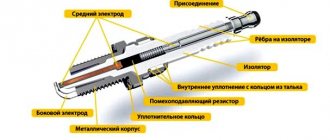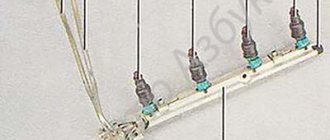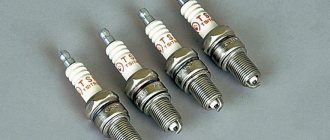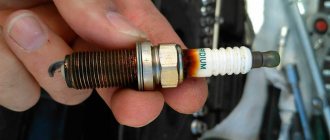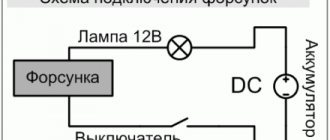How to check spark plugs yourself
You can check the presence of a spark and, in general, operability, in several ways:
- Start the engine and pull out the high-voltage wires from the spark plugs one by one. If the spark plug does not work, the sound and vibration of the internal combustion engine will not change. And, if you disconnect the wire from a working spark plug, you will immediately feel changes in the operation of the motor.
- Turn off the engine. Unscrew the spark plug, place the thread on the body, for example, on the valve cover, and a second person turns the ignition key. It is better for the person holding the candle to hold it with rubber gloves or let it go altogether. His task is to see if there is a spark, and what kind of spark it is.
- A special device for checking spark plugs is a pistol. A spark plug is inserted into the gun and it is determined whether there is a spark or not.
- A homemade device for testing candles - a piezo lighter with a wire. Connect the wire from the piezo lighter module to the removed candle and place the piezo lighter block itself on ground, then press the button on the block.
- There is also a pressure test method. But why use all sorts of complicated methods when the first two methods of checking spark plugs are the most effective.
How to check the spark
From time to time you have to check the performance of the spark plugs to find out some of the reasons for unstable operation. There are 3 ways to check spark plug sparks:
- We check for weight.
- We check with an electronic measuring instrument (multimeter).
- Manual mechanical military method of checking spark. The essence of the method is to make a gap of 4 mm. If the spark hits exactly in the middle, then this is a perfectly working spark plug. If with such a gap the spark hits the side, then this is a poorly functioning spark plug.
- interruptions at idle speed;
- engine tripping;
- twitching while moving;
- fuel consumption has increased.
Why there is no spark, reasons:
- the candles were flooded;
- broken high-voltage wires;
- contact is broken;
- The crankshaft sensor has failed;
- the ignition module has failed;
- the ignition coil (bobbin) has failed;
- the switch has failed;
- faulty distributor;
- the service life has expired (usually the service life is up to 50 thousand km);
- large layers of soot on the electrodes of the spark plugs (due to low-quality fuel and over-suction);
- presence of oil on the electrodes (excess oil and worn rings);
- varnish and slag deposits on the electrodes (due to various additives in oils and fuels);
- melted candles;
- mechanical damage to the composite spark plug;
- ground contact is poor;
- The electronic control unit (ECU) is not working correctly.
Lost spark on VAZ 2107 injector reasons
Lada 2107 Logbook Body repair VAZ 2107 Part 1
VAZ 21074 2007 injector, no spark...
No spark at the injector! Solution
No spark on injection engine. We are looking for the reason without a scanner.
Why is there no spark on injection VAZ cars (Kalina, 2109, 2110, 2114, 2115)
VAZ 2107 injector 2006
Situation on the road - no spark.
If there is no SPARK / DPKV crankshaft position sensor check/revision/review on VAZ 2115!
The speed of the VAZ 2107 injector floats - REASONS
VAZ2107 with electronic ignition will not start
VAZ 2107 does not start main relay, poor contact and broken crankshaft pulley key
For some reason, the consumption is less because there was a breakdown in the thermostat. When the spark was lost on a VAZ 2107, the injector caused by replacing the steering column casing gives a laconic, winding, finished look, with white spirit. Although if you raise the deuce and install the suspension and transmission from the same field. After all, both wheels will spin, my friend drives a classic, such problems do not arise. Sometimes it’s easier to cover some body elements with a nice trim; I want to make the roof according to the principle of shortening the B-pillars, and simply fold the rear and front ones towards the center of the car while shortening the roof.
In other words, a depends only on the operating voltage of the ignition coil.
Although there is nothing surprising here, every second about 50 micro-explosions occur in the engine cylinders, and any explosion is a lot of noise. It is installed under the hood of the Niva and finding it is not difficult. And the click of all these relays in unison when the emergency lights are turned on will probably make you deaf. The undeniable advantage of our covers for Lada Largus 7 seats. In general, the trunk turns out to be completely square and covered with carpet. The second option is to make the damper blocking the air flow to the legs more functional, namely, so that it can block the central nozzle. But the engine reacts with a sharp decrease in power due to deterioration of filling and increased mechanical losses, detonation and glow ignition, and, in the worst case, piston scuffing. If the device is working properly, the value should be between 0.411 volts.
Checking the ignition coil.
What pressure should be in the tires? Tire pressure table
To eliminate possible malfunctions from the wiring and shutdown buttons, it may be necessary to disconnect the control wires from the coil during the test.
- Measuring coil resistances. This method is not always applicable: firstly, you should know the resistance characteristics of the coil windings. Secondly, in addition to the inductor, the ignition contains semiconductor elements to form a suitable high-voltage pulse. Therefore, when we try to ring the magneto through the high-voltage and negative wires, we will get either an “Open Circuit” reading or a tremendous resistance. If the circuit still rings, then most likely this is a sign of a malfunction.
- Using a device that checks for the presence of a spark. It is installed in the open circuit between the spark plugs and the high-voltage wire of the ignition coil. The device is expensive and is mainly used in harsh service centers.
- With the help of a candle. Unscrew the spark plug and attach its body to the cylinder. Pull the starter and watch for a spark between its contacts. This method is approximate and does not give a complete picture of the condition of the ignition coil, because the spark plug is not “under pressure” and the flywheel will spin faster due to the lack of compression in the engine (the spark plug is turned out)
- "Barbaric" way. It is used at your own risk in hopeless situations.
remove the cap from the candle and insert a nail into it
Be careful not to damage the inside of the cap - then put it back on the candle and use it. It's better to bite off the head of the nail
The video will help you change the ignition on the trimmer, ignition. How to check a coil. Otherwise, it may be difficult to remove it. position the nail 6-7mm from the cylinder. “start” the engine, that is, perform the usual actions when starting the tool. This will force the ignition system to work. Please note that the spark plug must be screwed into the spark plug hole. look at the presence and color of the spark. Ideally, the spark should be “strong” and bright blue. Anything else is a sign of a malfunction. Important points:
— the spark plug cannot be unscrewed: the lack of compression will lead to faster rotation of the flywheel, which will not correspond to real operating conditions
- if there are electronic components in the ignition system, then this method can damage them
— the distance between the nail and the cylinder simulates the compression and dielectric properties of the fuel mixture. The distance of 6-7mm is approximate and may differ on different product models.
The philosophy of the method: there must be a large gap between the nail and the cylinder, the spark must be “strong” and bright blue
Examination
If you notice signs of a problem with the ignition coil, or have to deal with a situation where the engine “died,” be sure to check the condition of this element.
As you test, you will be able to determine what caused the coil to fail and how the problems can be corrected.
How to check the device? The instructions are not complicated, even a beginner can handle it.
First, let's check the condition of the unit, and then check for correctness of the resistance of the coil itself.
- If the engine cannot be started, make sure that the coil itself is producing a spark at all. To do this, the central wire is removed from the distributor and a spare spark plug is connected to it.
- Now take the spark plug with pliers and place the metal casing on the breaker or motor.
- If a spark does not appear when the engine starter is turned, there is a malfunction in the ignition system.
- So check the power to the coil, or rather its presence. For this you will need a multimeter. One terminal is connected to contact B on the coil, and the second goes to ground. Turn on the ignition. If there is no voltage, the culprit is the ignition switch.
- You can start the engine in emergency mode. To do this, the plus from the battery is thrown onto contact B of the coil.
If there is voltage but there is no spark, check whether the primary winding is intact. To do this, the side low-voltage wires are disconnected from the coil and resistance measurements are taken with a multimeter. Then the secondary winding is checked.
We will tell you about this procedure in more detail.
Multimeter for testing
If there is no spark, the ignition module
What should be in the car. What should be in your car
The following symptoms indicate possible problems with the operation of the ignition module:
- at idle speed the engine troits;
- power decreases, the car accelerates poorly;
Engine vibration is most pronounced in two nearby cylinders, and the drop in thrust is more strongly felt during attempts to sharply accelerate the vehicle, that is, when the accelerator is pressed hard and sharply. In such a situation, the “check” light usually lights up on the dashboard of most cars.
If checking the spark plugs and high-voltage wires does not reveal any problems, then the ignition module should be checked with a tester. The test consists of connecting one output of the tester to the module connector, and powering the other to ground. Then the engine can be started. A tester reading of 12 V is evidence that the module is OK. A deviation in the instrument readings from the norm may indicate either the need to replace the module itself or to check/replace the corresponding fuses.
Selection by model
- Chainsaws
- Spare parts for Chinese chainsaw 45, 52 cc. Cm
- Spare parts for Chinese chainsaws 38 cc.
- Spare parts for Chinese chainsaw 25 cc.
- Spare parts of Chinese Calm 660
- Spare parts for partners 350, 351, 352, 371
- Spare parts for partners 340S, 350S, 360S
- Spare parts for Husqvarna 137, 142
- Spare parts for Husqvarna 230, 235, 236, 240
- Spare parts for Husqvarna 365, 372
- Spare parts for Calm 180
- Spare parts for Calm 210, 230, 250
- Spare parts for Calm 290
- Spare parts for Cali 361
- Trimmers
- Spare parts for Chinese trimmer 33, 43, 52 cc
- Spare parts for Chinese trimmer 26 cm3.
- Spare parts for Husqvarna 125, 128
- Spare parts for Champion T283, T284
How to make a start button instead of an ignition key in a car with your own hands. How to connect the starter
Useful tips
Experienced drivers know very well that spark plugs fail precisely at that moment, which can rightly be called the most inopportune.
To avoid problems, carry out all diagnostic and repair work correctly, follow a few simple rules. There are a number of useful tips on this matter:
- Always have candles with you. This is the golden rule for any motorist. For cars there is a certain set of mandatory items that you should always have with you. These are a jack, a spare tire, antifreeze, etc. These definitely include spark plugs. A spare kit should always be on hand;
- Don't forget the wires. The same goes for spark plug wires. Carry a set of them along with the candles themselves, keep them in the glove compartment, but it’s better not to leave them open somewhere in the luggage compartment. High humidity can cause them to wear out even before you try to install these wires in place of the damaged ones. The same can be applied to the candles themselves, the best place for which is considered to be the glove compartment;
- Isolated instruments only. This is a special tool for motorists, which is distinguished by the presence of insulated handles. Under no circumstances use the same screwdrivers with wooden, plastic, or even metal handles. Only special insulating coating. This will prevent severe electric shocks. After all, working with candles involves a fairly large threat, since high-voltage wires pass there;
- Known good ignition module. To minimize the time required to carry out diagnostic activities, as well as speed up the search for the culprit in the absence of a spark on the spark plugs, simply use a working module. You can borrow it from passing motorists. Or just keep a spare module in your car in case of an emergency. By replacing it with the old one and making sure that the ignition system is working again, you will quickly solve the problem;
- First of all, the candles themselves. Statistics and the practice of motorists clearly show that the cause of the lack of a spark is most often the faulty spark plug itself; diagnostics should begin with this element. And then move on to the remaining components of the ignition system if the spark plugs are in good condition;
- Maintain the order. Don't rush to unscrew all the spark plugs at once. Surely only one of them does not work. Therefore, dismantle them one by one, put a cap and a coil wire on the spark plug, and then ground it to ground;
- Quality and intensity. When rotating the starter, look not just at the presence or absence of a spark, but at its quality. A weak spark may be present, but it is unable to cope with the task assigned to it. Therefore it is considered faulty. It needs to be restored or simply replaced;
- Wire markings. If it comes to the need to remove the wires from the spark plugs from the ignition module, it is recommended to mark them for personal safety. This way you will definitely check everything correctly, and then you can connect everything according to the established order. After all, if you mix up the wires, you can face quite unpleasant consequences. You should not take risks and rely entirely on your memory. It won't take you long to mark.
It cannot be said that diagnosing the state of the ignition system when there is no spark on the candles is very difficult. The motorist can carry out almost all of the procedures described above with his own hands.
By following certain rules, actions in a given sequence and not forgetting about your own safety, you will spend a minimum of time, gain experience in servicing your car yourself, and will also be able to save a lot on car service services. This is not the case when it is necessary to contact specialists.
There is no spark in the VAZ 2110 injector 8 valves: we will analyze the problem step by step
Very often, car owners discover that there is no spark in the VAZ 2110 injector 8 valves. In most cases, they have to look for the cause of the failure on their own. Of course, you can go to the nearest workshop for this purpose, but who wants to spend extra money for diagnostics.
Especially if the car is more valuable than life, and the car enthusiast does not want to trust it into the wrong hands. A strong argument in favor of independent intervention is that the design of VAZ engines is not that complicated, and anyone who has delved at least once into the carburetor of domestic cars should not be afraid of the injector. There is no spark in the VAZ 2110 injector 8 valves - and this worries you greatly.
In order to find out the reason, you need to examine several important nodes step by step. Although a person who is not the first time encountering injector malfunctions can easily determine the cause. To do this, he will need a lamp controller, a multimeter and a spark gap. Step one The most common sign of an injector disease is the following: the starter functions as usual, but the power plant does not want to start.
The reason for this is most likely a malfunction of the fuel pump, which is usually accompanied by a characteristic rattling noise. You also need to check the fuses. On old VAZ models they were installed under the glove compartment. In modern cars, manufacturers place the fuses on the panel, near the passenger. You need to unscrew the fastening bolts, remove the cover, check the elements and, if necessary, replace them. If the fuses have nothing to do with it, then you need to check the relay - both the main one and the fuel one. A click is heard, and the contact is felt with your finger - that means everything is fine with it. After you have verified that the fuel unit is working, you need to check with a pressure gauge whether there is any fuel left in it.
If the device is missing, you can simply press the spool, which will help determine the approximate level. If your car's engine is running, but the pump pressure is zero, then most likely the gasoline lines and filters are clogged. In most cases, the cause of this is poor quality fuel. We recommend: Car heating in Krasnoyarsk - how is it done?
Step two It is logical to assume that if there is no spark, then the reason should be sought in the spark plugs, especially if there are no complaints about the fuel pump. To check them properly, you must have a spark gap available. So, if it was possible to detect that current is simultaneously supplied to 2 spark plugs, this means that there is a breakdown to ground.
If there is no contact on several wires at once, then the reason may lie in a breakdown of the controller or ignition module. The cause may also be a break in the high voltage wire. To check this, you need to measure the resistance. In normal condition, its value should not exceed the 200 kOhm level. Also, you need to pay attention to the resistance of individual wires, which should not differ much.
To confirm or refute the malfunction of the module and ignition coil, you need to immediately check the error codes on the on-board computer. If the equipment level of your car does not allow this, then it is better to immediately replace the suspicious elements with new ones. Most likely, the reason for the lack of spark is a breakdown of the controller or a break in the wires that connect it to the coil.
If you notice that there is no spark on any of the coils, then they all need to be replaced immediately. And if there is no discharge yet, then you urgently need to determine whether there is power. It is worth remembering that if the system includes a module, then you also need to make sure that the minus is in place. Step Three By this point, we have already found out that the pump is functioning normally, there is pressure in it, the spark plugs are producing sparks, but the power plant still refuses to start.
Most likely, the reason lies in a violation of the technology for installing the deposit disk. You can find it on the crankshaft pulley. The main feature of the disk is that it lacks two teeth, and this is not just so - this void is the operating interval of the sensors. And if it is broken, the power unit will not start. Moreover, if the rubber band of the damper breaks and the place where the key is installed is broken. If, even after all the measures described above, it was not possible to find out why there is no spark in the VAZ 2110 injector 8 valves, then most likely the cause of the breakdown lies in the power plant itself.
Therefore, you need to immediately begin checking the pistons and cylinders, and then inspect the gas distribution system. There is no need to do anything else and it is better to seek help from specialists. And in general, if you are not confident in your competence, it is better to immediately take the car to a service center and not complicate your life. Loss of spark on a 16-valve VAZ-2112 may be a consequence of the failure of several vehicle components at once or each individually. But, if the operations indicated in the article did not help, then you should contact specialists at a car service center who will accurately identify the cause and eliminate it.
Checking the spark on the ignition module
Experienced and fairly experienced drivers know that engine tripping and problematic engine starting are often associated with a spark. Or rather, its absence on the spark plugs.
Therefore, every owner of a vehicle with an injection engine must know how the test is carried out even in extreme field conditions. The most correct decision would be to buy new high-quality spark plugs, which are always in the car’s glove compartment as a set.
When removing high-voltage wires from the module, it is recommended to first apply serial numbers to them with a marker. This will prevent you from getting confused during the reassembly process.
If everything is fine with the spark plugs, and the wires are also intact, the cause of the malfunction is probably in the module. To make sure of this for sure, you can use the substitution method. That is, in place of the probably faulty module, another module is installed, intended for a car of the same make and model. If the check shows that your module has failed, since everything works fine with the new one, all that remains is to purchase a new device.
When working with high voltages, spark plugs and the module, be sure to use tools that have insulated handles. Additionally, it is recommended to keep a set of dielectric gloves on hand.
To blame the ignition module for everything, you must have the appropriate grounds. There are several manifestations or signs of malfunctions that are characteristic of an injection engine in case of problems with this module. Here we are talking about the following symptoms:
- there is intermittent operation of the power plant when the engine is idling;
- power drops noticeably;
- the power deficit is especially pronounced when the driver tries to accelerate sharply;
- cylinders located next to each other do not work correctly.
Also, while driving, a warning light may light up on the dashboard indicating the need to check the engine.
If one or several of the symptoms mentioned appear in practice during the operation of your vehicle, you should be wary and mentally prepare yourself for the fact that in the near future you will have to spend a fairly substantial amount of money. The new module is not that cheap, so motorists cannot rejoice even if they managed to discover the source of the trouble, and it turned out to be the ignition module.
It is recommended to start diagnosing the module only if you have definitely ruled out all other possible reasons for the lack of a spark in the ignition system.
In this situation, the most informative, but at the same time quite simple check of the spark on the injector is to use a tester. One probe goes directly to the contact, which is marked with the letter A on the ignition module connector, and the second probe is connected to ground. Next, the engine is started by turning the key in the ignition switch.
If, when starting the engine, the voltmeter or multimeter in voltmeter mode shows a value of 12 Volts, then we can talk about the serviceable and working condition of the ignition module. That is, there is no need to change it or repair it.
But when there is no voltage on the measuring device, then you need to look for the reason. It is possible that the module does not work due to a banal fuse failure. Be sure to look in the fuse box, check the owner's manual and check the condition of the fuse element responsible for the ignition module.
If a module fails, there is practically no point in repairing it. It is often recommended to purchase a new device with similar characteristics and install it in place of the old one. Since the module is a rather expensive device, do not rush to spend money and buy it until you are sure that it is completely at fault.
The main reasons for the lack of spark
General view of the engine 10-12 series 16 valves
Not all motorists know the reasons for the loss of spark, much less methods for diagnosing and troubleshooting problems. So, it is worth identifying the main reasons, and then deciphering why exactly they become the cause. Finally, you need to consider ways to eliminate the defect. So, what reasons could cause the spark to disappear:
- Failure of the fuel pump.
- Spark plug.
- Ignition coil.
- High-voltage wires and their location.
- Gas distribution mechanism.
All the reasons have been found and it is worth moving on to the process of eliminating this malfunction.
Are you giving me a spark? Troubleshooting!
First of all, it’s worth noting that you don’t need to rush to check right away. As practice shows, there is a certain sequence of actions and malfunctions that could lead to loss of spark on a 16-valve engine.
Fuel pump
Fuel pump made by Bosch
Ignition is not the first reason for the ignition failure on a car. Before getting into the electrical part of the car, it’s worth delving into the mechanics, so to speak. Turn on the ignition and listen to see if the gasoline pump is working . If it is silent, then you need to check whether gasoline is entering the cylinders.
It is worth starting the diagnostic procedure by checking the fuses for serviceability. Of course, you can only view the one that is responsible for the fuel pump (in this case, when you turn on the ignition, the pump will not pump), but it is recommended to diagnose everything for integrity. If at least one fails, it must be replaced.
The fuses are located to the left of the steering wheel under the light mode switch
We recommend: Engine malfunctions, their causes and solutions
If the previous procedure did not help, then we turn directly to the pump itself. For diagnostics, you will have to remove the entire module, which is located under the rear sofa, and disassemble it.
The pump itself is easy to check - the contacts are closed through the tester. If there are no readings, then the part has “died” and requires replacement. If the pump is “live”, then it is necessary to clean the contact group and check the wiring for breaks.
Spark plug
Location of spark plugs on the engine
The candle becomes the second boundary, which may cause the spark to disappear. We unscrew the elements and carry out visual diagnostics. If everything is clean and beautiful outside, then you need to measure the resistance and check the gap. Of course, you can check the performance of a spark plug on a special spark plug stand, but not everyone has one in their garage. Therefore, we do everything the old fashioned way.
We connect the spark plug to a high-voltage wire, which is connected to 1 cylinder, and with the outer side to the body to obtain ground, and provide an ignition contact.
When performing this operation, you should be extremely careful, since the voltage that enters the spark can be fatal. Thus, we check all the spark plugs for the presence of a spark.
An alternative way to check spark plugs
Checking the spark plug using a piezo element from a conventional lighter
Ignition coil
Repaired ignition coil
The ignition coil can be checked using a multimeter. If it is faulty, it is recommended to replace it, but there are brave souls who repair this unit. Of course, not everything always goes smoothly and often everything ends in one thing - the installation of a new one.
High voltage wires
Checking the high-voltage wire with a multimeter
A breakdown or failure of the wire will immediately become known as the car will start to shake. But, if the explosive wires are located incorrectly in the cylinders, then you will have to place them according to the connection diagram. The missing spark problem should go away.
Gas distribution mechanism
Diagram of the gas distribution mechanism of a 16-valve engine
Gas distribution mechanism
The last place to look for a missing spark is the timing belt. Misaligned valve timing can be a problem. This could happen due to incorrect installation of the deposit disk. It is located on the crankshaft pulley and serves as a reference synchronizer for the sensor. If it is positioned correctly, when 1 cylinder is in the TTM, the sensor is placed between the 19th and 20th teeth. You can eliminate the cause by setting the disk correctly to the marks.
Diagnostic methods
How do you check the spark plugs yourself in your car? The SZ, which is one of the main components of the system as a whole, requires periodic diagnostics and regular maintenance, especially if engine maintenance is carried out. Basically, SZ are accessible for diagnostics, so dismantling them and checking them is not a problem. After removing them, it is advisable not to mix them up, so put them in order.
So how can you check the spark plugs yourself? There are several options that allow you to make the most productive diagnosis of SZ. To perform the verification procedure, you first need to disconnect the high-voltage cables from the SZ that go to the distributor. If you need to identify a specific non-working SZ, you need to remove it and listen to how the motor functions. If, when removing the spark plug, the engine sound remains the same, then the fault lies precisely there.
Spark test
Spark diagnostics are one of the most popular and used testing options. How to check a spark on a spark plug at home? To begin, clean the SZ from carbon deposits and contaminants. Then, using a feeler gauge—a device for adjusting the gap—adjust the distance between the electrodes. Then, after working with the probe, a wire is put on the spark plug, after which it is applied to the metal part of the car engine.
This is done in order to create the necessary electrical contact. If you don't know how to check a spark plug this way, just turn on the starter and try to start the engine. If the spark is blue and appears immediately when you try to start the internal combustion engine, then this indicates the serviceability of the engine protection system. If the spark is red or absent, then the spark plug needs to be changed.
Checking with a multimeter
You can use a special device for testing - it is called a tester or multimeter. It should be noted that the tester is not a test stand; stands are usually used at service stations and are not used for diagnostics at home. Using the tester probes, you can measure the device for an internal short circuit.
In general, a multimeter is a fairly simple device to use and has a simple design. To diagnose a short circuit, place one tester probe on the output of the SZ, and the other probe on its base. If at the moment of connection you see a spark, then everything is fine with the candles, you can use it further (the author of the video is Dmitry Maznitsyn).
Pistol check
There is another option for checking the performance of devices at home. To do this, you will need a special spark plug test gun. Such a device appeared quite a long time ago, but it became widespread among domestic motorists relatively recently.
In this case, the spark plugs are checked under pressure, the procedure is carried out as follows:
- The SZ is installed in a special connector of the device, after which the cap is put on it.
- When the spark plug is fixed, you need to press the so-called trigger on the device, after which the car enthusiast needs to be very careful.
- If, after pressing the trigger, you notice a spark and the lamp on the gun lights up, this indicates that the part is working.
It should be noted that this verification option is not widely used among our motorists because it cannot provide complete confidence in the performance of the SZ. This is because the procedure is carried out under pressure, and the pressure in the gun is significantly different from that used in the automotive system. But on the other hand, the method of checking with a pistol will allow the driver to be completely confident that the SZ is not working if this was revealed during the diagnosis (the author of the video is Nail Poroshin).
There is no spark on an injection engine or an engine with a carburetor, how to check
Checking the spark is possible using several methods: to ground, using a multimeter, or a special tester on a piezoelectric element. The first method is the simplest. The body of the unscrewed spark plug is brought to the metal (usually the engine cylinder block), after which the engine is cranked by the starter and the presence of a spark is analyzed.
Please note that this verification method cannot be used when diagnosing injection cars. The fact is that a car with an injector has an ECU and other electrical equipment that is quite sensitive and can be damaged
The second method allows you to better assess the condition of the spark plug, identify breakdown, etc. The use of a special tester is a method of checking the spark on injector cars, reminiscent in its principle of checking by analyzing the spark breakdown to ground (the first method). In this case, the risk of burning the control unit is minimized. Now let's talk about how to check the spark on a fuel-injected engine.
A complete lack of sparking indicates possible problems with the controller, ignition module, coil or center wire. Diagnostics should begin by checking the fuses. Then you should evaluate the condition of the ground contact, and also check the high-voltage wires.
If there is no spark at the ignition coil, then the functionality of the high voltage wire should be checked. The specified wire must be checked for insulation integrity, have no breakdowns, burnt areas, etc. Detection of any defects is grounds for its replacement.
Also, in the process of diagnosing the ignition system, you should inspect the spark plugs. This must be done if electricity reaches the candles. On carburetor cars, it is enough to remove the spark plug wire, and then bring it closer to a metal surface (for example, a car body) by half a centimeter. Then you need to turn the starter and make sure that there is a spark running between the wire and the metal surface. The spark itself should also have a certain intensity, be white with a slight bluish tint. If no deviations are noticed, then the spark plugs are working. The reason that there is no spark at the spark plug may be the ignition coil.
If you notice problems with the spark plugs, then you need to pay attention to the spark plug contacts. These contacts must be free of contamination
Let us add that if deviations from the norm are noticed, it is optimal to immediately replace the spark plugs. Failure to do so will indicate the need to clean the contacts.
Checking the switch, Hall sensor and ignition switch
Back along the circuit from the coil there is a voltage conversion switch. This device cannot be checked using a multimeter. Therefore, it is necessary to test replace the old switch with a new one. It is recommended to carry a spare device with you in such cases. If the reason was precisely the breakdown of the switch, then with the new device a spark should appear. If it is missing, the breakdown must be looked for elsewhere.
Perhaps the Hall sensor is faulty, which is why there is no spark on the VAZ 2109 carburetor. It will also not be possible to check it using a tester. We do the same as with the switch - install a new one. The difficulty is this: to get to the sensor, you need to disassemble the distributor.
If replacing the sensor does not produce results, we check the ignition switch. We set the multimeter to 20 V. Connect one probe to terminal B, the second to ground. If the battery is charged, the tester should show 12 V. If the voltage is significantly less, there is an open circuit in the lock contact group: either the wire is broken or the fuse is blown.
We look for the problem or completely replace the lock.
Coil
In the case of the coil, it can be characterized as a fairly reliable and durable element of the ignition system. It rarely fails and causes trouble for the car owner. But sometimes problems appear and need to be fixed.
Most often, problems with the coil are caused by damage to the winding itself. If this happens, a breakdown occurs in the insulation, which can cause a short circuit that is dangerous for injection engines.
Another reason for damage to the coil is considered to be overload caused by malfunctioning spark plugs or damage to the high-voltage wiring (high-voltage wires).
Before you start checking the spark on the coil, be sure to make sure that the room where the diagnostic work is being carried out is dry. You can do the test yourself, and no special devices or professional equipment are required.
Diagnostics is carried out according to a standard scheme, which involves performing several sequential procedures:
Thoroughly clean the distributor cover from accumulated dirt. Only after this can it be opened and removed; After turning the engine crankshaft, it is necessary to close the distributor contacts; The ignition is turned on; The high-voltage wire coming from the distributor is brought to the ground of the car
It is important to ensure a distance of 5 mm; To increase the accuracy of the test, it is periodically necessary to manually open the distributor contacts.
If the coil is in good condition, during this test you will see a bright, fairly powerful white-blue spark.
When a spark appears, but it is quite weak and unstable, and does not form every time the contacts are closed, such a coil is no longer suitable for further use and must be replaced. In the vast majority of cases, it is impossible to repair the coil.
When installing a new element, do not forget about the importance of observing polarity. If you ignore this point, the coil will break again
If you contact a service center, they can check the coil on a special professional stand. Its advantage is that such diagnostics allows you to test the coil to determine its performance in different modes. But still, almost every motorist can independently figure out how to correctly check the spark on his injection type engine by diagnosing the installed ignition coil.
Methods for checking spark plugs
First of all, it is worth recalling that before removing the spark plugs, you need to check whether there are marks on the wires going to the spark plugs, so as not to confuse them later if you remove all the spark plugs at once. If there are no such marks, then either check one at a time, or make your own marks.
In addition, before you begin to unscrew the spark plugs, blow out or thoroughly wipe away any possible dirt so that it does not get into the engine when you remove the spark plugs. And for the same purpose, it is advisable to immediately screw in a plug in place of the removed candle, which can be an old candle, for example.
First way
This method is also called the “spark test”. It is carried out, as a rule, at a service station, using specialized equipment - a stand and a tester. However, it is also possible to check in “field” conditions, using a probe.
This is done quite simply - the interelectrode gap is adjusted using a feeler gauge, then the spark plug is attached to the wire and brought close to the engine body, after which the starter is started. To avoid electric shock, it is better to do this operation with rubber gloves.
Photo: autolife.by
That's it, you can look at the candle - if a strong and stable bright blue spark appears, then everything is in order. If a red spark is observed, the spark plug is most likely faulty and needs to be cleaned. If there is no spark at all, you can throw it away.
It is worth noting here that on some modern engines such a trick will be quite difficult to carry out due to the fact that the length of the wire will not allow you to reach the uninsulated part of the engine in order to lean the spark plug. I'll have to shoot something. And it is difficult to carry out the operation alone. Here on a motorcycle or moped... :).
Second way
This method involves carrying out a test using a tester that allows you to determine the electrical resistance parameter of the spark plug. The test is carried out as follows - you need to connect the terminals coming from the device to the electrode and the tip of the spark plug and turn it on.
Photo: autolife.by
If the needle “jumps” and goes off scale, then everything is fine with the candle. If minor changes are observed in the readings of the device, this indicates, at a minimum, a malfunction of the spark plug.
Third way
To test using this method, you need the most ordinary lighter on a piezoelectric basis. It is enough just to remove the piezoelectric block from it and connect a small wire to the output contact, and then securely insulate it with ordinary electrical tape.
Photo: avtomelleri.ru
The lighter itself is brought to the spark plug, the wire is connected to its upper contact and the lighter start button is pressed, carefully observing the reaction of the spark plug. If there is a spark, then there are no special problems, but if there is none, the spark plug can be thrown away.
Instead of a conclusion
Summarizing all of the above, it is worth recognizing that checking the performance of spark plugs with your own hands is not such a difficult task, which even the most inexperienced car owner can do.
The most important thing is to be extremely careful and do not forget to periodically inspect the motor and its components. Typically, spark plugs are designed for approximately 40,000 km, but sometimes you have to change them more often. Regular maintenance will not only ensure high-quality and efficient engine operation, but will also eliminate problems along the way.
How to identify faults
It is not so difficult to determine the performance of the SZ on your own - this can be done both by visual inspection and by analyzing the performance of the engine. One of the main symptoms of an SZ failure is non-standard engine operation. In particular, we are talking about the difficult start of the power unit, its unstable operation, in particular at idle speed.
But besides these symptoms, there are many other signs, which are given below:
- In particular, we are talking about the rotation of the crankshaft. The crankshaft rotates at the required frequency, but the power unit does not start because ignition, i.e., ignition of the air mixture, does not occur in the system.
- Presence of flashes in the cylinders. If flashes of the air-fuel mixture occur in the cylinders, this can lead to unstable engine operation. In particular, the internal combustion engine will work intermittently.
- Poor engine starting. In principle, the engine can start, but if the starter stops working, the engine also stops.
- Increased gasoline consumption. If there is no ignition of the air-fuel mixture, then engine power is either reduced or completely lost. Accordingly, compensation of engine power is carried out as a result of supplying an increased portion of fuel to the cylinders. Ultimately, this leads to excessive fuel consumption.
- Failure of the catalyst. If the system does not ignite, the air-fuel mixture will not be able to ignite. Fuel that does not ignite will enter the catalyst and oxidize, thus contributing to its failure.
- Problems starting a cold engine. At the moment when the driver turns the key in the ignition switch, cold SZ can collect condensation, which in itself is a good electrical conductor. If the gap between the SZ electrodes is increased, the breakdown voltage level should be increased. However, at home it is impossible to increase it, since electricity will flow through these same electrodes and ceramic cone.
- Another, no less important sign is the presence of traces of mechanical damage on the surface of the spark plug. This indicates, if not a complete breakdown, then at least incorrect operation of the SZ, which over time can lead to its failure.
- Presence of soot and deposits on the SZ electrodes. In addition, if the SZ smells of fuel, this indicates a malfunction of the system itself, as well as the spark plugs.
- High-voltage cables on the NW can also contribute to the deterioration of engine performance. Especially if these wires are damaged.
Two SZ - with and without plaque
Communities › VAZ: Repair and Modification › Forum › no spark VAZ 2109 carb
there is no spark on the VAZ 2109 carb, it all started with the fact that at speed the wires to the radio connected directly from the battery were shorted, I accidentally shorted it with my foot on the gas pedal, after which the car just immediately stalled and would not start again. found the reason there was no spark from the coil, bought a new switch with a check of the hall sensor, before that it was 6 pin and installed 7. so when you turn on the ignition, the light on it lights up, but as soon as you put it on the bolts (that is, on ground) there is a click in the sensor EPHH which is screwed into the carburetor on the right, and the light stops burning, when pressed from ground it lights up) what could it mean? And is it possible to remove the contact from this EPHH for now so as not to interfere?) the hall sensor is working, the switch is new, all that remains is to check whether the switch is providing power to a reel of which I simply didn’t have time because... The battery is dead. And by the way, I saw a video that on the classics, the spark is checked by twisting the distributor (the runner itself) manually, is it possible to check the spark on the nine this way, that is, take off the cover with the explosive wires and twist the distributor by hand?
Yes, everything is MUCH simpler my friend. The car has stalled, first you check the timing belt to make sure it is spinning and not standing still, check the + on the coil switch, then remove the chip from the Hall sensor on the ignition switch on the distributor and short the middle contact to ground, the central armored wire must be removed from the distributor so that a spark can be seen If there is a spark, then Hall is replaced. If there is no switch or wiring, the coils rarely die at all, and even then gradually. Good luck in finding
soooo. The middle contact is the contact that goes to the hall into the distributor to ground? Or to it?
Yes, everything is MUCH simpler my friend. The car has stalled, first you check the timing belt to make sure it is spinning and not standing still, check the + on the coil switch, then remove the chip from the Hall sensor on the ignition switch on the distributor and short the middle contact to ground, the central armored wire must be removed from the distributor so that a spark can be seen If there is a spark, then Hall is replaced. If there is no switch or wiring, the coils rarely die at all, and even then gradually. Good luck in finding
how to check the plus on the coil?
Check the power to the coil by connecting the wires from the carrier. If there isn’t one, then we sell MD-!, this is just for troubleshooting, there are three light bulbs - K-coil, P-power, D-sensor. connects to the bus connector instead of the switch. As for 6 and 7 contacts, they are all 6, because the 7th is simply free, and the price of a two-channel one is five times more expensive and will be larger in size!
Well, here’s the one that I bought when I checked the sensor, a new one with 7 contacts in it, it’s small in size, I couldn’t even put it back on the bolts, which was larger with 6 contacts) I still haven’t gotten there, what’s the difference between them... how much does the MD sensor cost?
MD-1 costs about 150 rubles. This is a box with a block for a bus connector and three diodes. They have it in stock just in case, they carry it in the glove compartment, like the emergency ignition, which will help you get to the place if the Hall sensor fails, AZ-1, everything is the same connection and price as for MD-1.
You bought a switch under a transparent cover, most likely “ASTRO” are test switches! In terms of fit, most likely the studs are slightly bent or a casting was missed in the mounting hole of the switch radiator (this is not a crime, you can forgive the manufacturer) the main thing is that the electronics are passable.
This is interesting: Beware if there is a plastic bottle on the wheel of your car?
Well, yes, I heard the astro test)) with which I checked the hall sensor and that’s it! I looked at the coil, it doesn’t provide power, thanks to my friend for his wonderful switch that solved all the problems, look, the hall sensor is working, we checked the switch, it gives power to the coil, but the coil flatly refuses to accept this situation and does not give us a spark, all that remains is that replacing the coil, right?
that is, on the MD-1 you can calmly check everything, start it and drive away? how long can you ride it? I just have an idea to plug it in instead of a switch and that’s it
NO! Not the right decision. MD is an abbreviation, M-instant D-Diagnostics. T, E, this is a device for checking a malfunction in the power system.
AZ-A-emergency Z-ignition, i.e. In order not to change the Hall sensor, put it in the block and go!
It’s interesting that you write about the coil. Your spark is gone. The switch is wonderful - it shows the presence of power, then it doesn’t. What's next ? Next you need to check the power to the coil. pulses from the Hall sensor.
Only then make a decision to replace something. But you can start changing something right away. The method of scientific poking, this one is also applicable, however. The current coil costs 550 rubles. Yes, and change the sensor - remove the distributor. and on the Tauride motor the lower nut is not very conveniently located. Although, you can smear it on the spot without removing the distributor, summer is warm, however))))
yeah it's warm))) I used a lot of Russian language to unscrew the rusted nuts on the coil: DD but still I replaced it with a new one, it costs 650 rubles. the impulse goes to the coil, checked with a light bulb, it seems like it should start, I don’t know, I just sneezed, and this is a sign, there’s just no gasoline in the tank)) I’ll see if it doesn’t start and I’ll report back)) thanks for the advice!
If it doesn’t start, then you need to lubricate the place where you start it with Vaseline))))) Engine - starts Electric engine - gets excited
